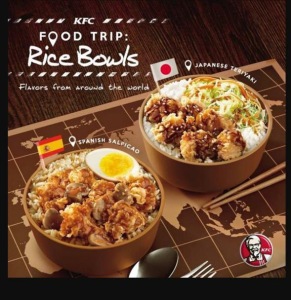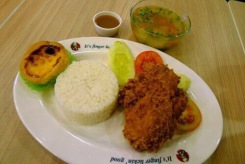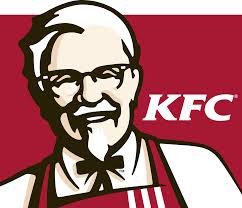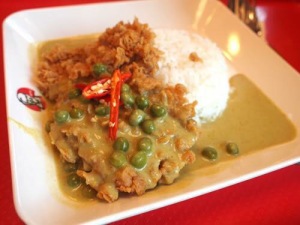A comprehensive understanding of cultural background of customer is important for marketers. Customer buying behavior is influenced by cultural, traditional, social and lifestyle. According to Kotler et al. (1996) identified that culture is the most basic cause of a person’s wants and behavior.
This is clearly reflected in the example of many KFC restaurants in terms of food culture style in difference countries. Asian cultures and Western cultures are distinctly different. We can see KFC products are different in term of flavor and ingredients around the world. KFC adapt the product to be appropriate with a local.
For example, KFC in China offered the bamboo shoots in spring and customer can buy the lotus roots in summer. As well as, some of dishes are cooked by adding Chinese ingredient such as sesame oil, Chinese cinnamons and aniseeds.( www.kfc.com.cn )

In addition, KFC in Japan caters to local tastes by offering rice product, such as bowls and the chicken cooked by Japanese sauce as teriyaki sauce.
While, KFC in Vietnam, a meal will be served with a Vietnamese style soup. And KFC in Thailand, chicken are cooked by Thai herb to make a food more spicy and sour taste as thai style food. Some menu, chicken is served with green curry and rice.

We can see that KFC’ international menus seem to have no limits what they serve as a Chinese version, Vietnamese version, J apanese version and Thai version. The product strategy of KFC is mainly affected by traditional taste. However, understanding local consumer behavior help to design the product strategy and to reasonably develop product suitable for local people in several location.
As a result of customizing meals to local taste and preferences,consumer would perceive lower level of risk including financial and functional risk because they know that by buying food from KFC they can fullfill their hunger and their money will not be wasted.



KFC in Japan is also huge during Christmas. People sometime have to book “Party Barrels” up to two months in advance. The party barrel includes a Christmas cake.
LikeLike
KCF in Japan during Christmas they have “Party Barrels” which they need to book in advance of up to two months. The Party Barrel comes with a Christmas cake.
LikeLike
Sorry, had issues and I thought the first comment didn’t upload.
LikeLike
This is a fantastic example of a big company trying to lower perceived risk with familiarity! It is also worth noting that this isn’t just the case for KFC, lots of other fast food franchises also do the same thing.
I have recently travelled throughout Europe, and found very similar things in some fast-food outlets. Another interesting example of this is Mc Donalds, and even though in Europe the countries are quite close together they still have different options on their menus.
In France Mc Donalds franchises sell croissants and baguettes, in Switzerland they sold “Toblerone Mc Flurrys”, in Germany “currywurst sausages” were available, and in Italy pasta side salads were on offer with main meals.
These options were specific to each country and were not available in different countries.
They not only have differences in foods but also in pricing (i presumed dependant on financial situation of the specific country).
I wonder how many of the people who live in these countries eat these border-line stereotyped foods though, or if it is just a gimmick for travellers?
LikeLiked by 1 person
Making food culturally sepcific is really just an example of knowing your market/customer. I wonder how some of these cross cultural ideas would go in a “Multicultrual” country like Australia where the marketing is still pretty general anglo-saxon/western, or for a “limited time only” in regards to a specifc flavour.
LikeLike
Very insightful article about how KFC has understood consumer needs and adapted, whilst still keeping product authenticity. This probably is the reason why people around the world recongnise KFC. Also in reply to an above comment by skather, in Asian countries KFC is regarded more like an expensive restaurant than a fast food outlet, and customers of KFC really appreciate the lower cost rice meal with a piece of KFC yummy chicken accompanying it. In Sri Lanka where I come from, KFC introduced the KFC chicken buriyani at a very affordable price. When I go on holidays to Sri Lanka its a very tasty, successful twist to the KFC I enjoy in Ausi and deffinetly a dish you can recommend to a foreign traveller.
LikeLike
Although KFC is an international organization they cannot simply offer the exact same product to all their consumers because their tastes vary mainly because of cultural differences. Customising the product to local preferences helps to endear it to the local population and reduces the perceived risk of buying that product.
How does KFC maintain quality standards if their product offering is not standardised and varies from country to country?
I noted one interesting thing: that while the food varies from country to country – the branding looks exactly the same internationally. Will customising the branding of the product (i.e. logo, colour scheme) further reduce consumer’s perception of risk?
LikeLike
answering the first question, each country should have its own quality control over those of different food and products, due to the fact that each country has its own headquarter so the headquarter is be able to control over all of the products quality in its country. Moreover, customising the brand may effects the products in the way of changing the way of how consumer perceived the brand but in my opion i do not think it would effect the company as a whole as long as KFC can remain its great products quality and value in the market.
LikeLike